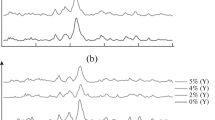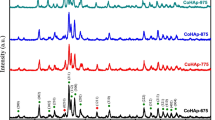Abstract
Lattice and surface impurity reactions and structural changes induced by them in slightly carbonated hydroxyapatite (SCHA) treated at 25–1100ºC were comprehensively studied. The SCHA was processed by a conventional wet synthesis at a high possible temperature (96ºC) using ammonium containing parent reagents. IR-spectroscopy, XRD, TG-DTA technique and mass spectrometric thermal analysis (MSTA) were employed for characterization of the samples. \( {\text{NH}}_{4}{}^{+ } \) with \( {\text{H}}_{{\text{3}}} {\text{O}}^{{\text{ + }}} \) in cationic- and \( {\text{CO}}_{3}{}^{2 - } \) (A- and B-positions) with \( {\text{HPO}}_{4}{}^{2 - } \) in anionic sites, and H2O, \( {\text{CO}}_{3}{}^{2 - } \)(\( {\text{HCO}}_{3}{}^{-} \)) \( {\text{NO}}_{3}{}^{- } \), N x H y on the surface of particles were found and considered as impurity groups. Complicated changes in lattice constants of the SCHA stepwise annealed in air (for 2 h) were revealed; the changes were associated with reactions of the impurity groups. Filling the hexed sites with hydroxyl ions above 500ºC was shown to happen partly due to lattice reactions but was mainly owing to hydrolysis of the SCHA by water molecules in air. Decomposition of \( {\text{CO}}_{3}{}^{2 - } \) groups proceeded through both thermal destruction and reactions with some of the impurity ions. The decarbonation in A-sites occurred at much lower temperatures (450–600ºC) than in B-sites (700–950ºC) and was first revealed to happen in two stages: due to an impurity reaction around 500ºC, and then through thermal destruction at 570ºC. A redistribution of \( {\text{CO}}_{3}{}^{2 - } \) ions, decreasing in amount on the whole, was observed upon annealing above 500ºC. To avoid possible erroneous conclusions from TG-data, a sensitive method was shown to be required for monitoring gaseous decomposition products (such as the MSTA in this study), in case several impurity groups were present in a SCHA.







Similar content being viewed by others
References
Dry ME, Beebe RA. Adsorption studies on bone mineral and synthetic hydroxyapatite. J Phys Chem. 1960;64:1300–4. doi:10.1021/j100838a042.
Bett JA, Christner LG, Hall KW. Studies of the hydrogen held by solids. XII. Hydroxyapatite catalysts. J Am Chem Soc. 1967;89(22):5535–41. doi:10.1021/ja00998a003.
Nagai M, Nishino T. A new type of CO2 gas sensor comprising porous hydroxyapatite ceramics. Sens Actuators. 1988;15:145–51. doi:10.1016/0250-6874(88)87004-5.
Jeanjean J, Rouchaud JC, Tran L, Fedoroff M. Sorption of uranium and other heavy metals on hydroxyapatite. J Radioanal Nucl Chem Lett. 1995;201(6):529–39. doi:10.1007/BF02162730.
Reichert J, Binner JGP. An evaluation of hydroxyapatite-based filters for removal of heavy metal ions from aqueous solutions. J Mater Sci. 1996;31:1231–41. doi:10.1007/BF00353102.
Ratner BD, et al. Biomaterials science: an introduction to materials in medicine. In: Ratner BD, et al., editors. California: Elsevier Academic Press; 2004.
Narasaraju TS, Phebe DE. Some physico-chemical aspects of hydroxyapatite. J Mater Sci. 1996;31:1–21. doi:10.1007/BF00355120.
LeGeros RZ, Bonel G, Legros R. Types of “H2O” in human enamel and in precipitated apatites. Calcif Tissue Res. 1978;26:111–8. doi:10.1007/BF02013245.
Feki HE, Savariault JM, Salah BA. Structure refinements by the Rietveld method of partially substituted hydroxyapatite: Ca 9 Na 0,5(PO 4)4,5(CO 3)1,5(OH)2. J Alloy Comp. 1999;287:114–20. doi:10.1016/S0925-8388(99)00070-5.
Rehman I, Bonfield W. Characterization of hydroxyapatite and carbonated apatite by photo acoustic FTIR spectroscopy. J Mater Sci Mater Med. 1997;8:1–4. doi:10.1023/A:1018570213546.
Zyman Z, Rokhmistrov D, Ivanov I, Epple M. The influence of foreign ions on the crystal lattice of hydroxyapatite upon heating. Mat-wiss Werkstoftech. 2006;37(6):530–2. doi:10.1002/mawe.200600032.
Gibson IR, Bonfield W. Novel synthesis and characterization of an AB-type carbonate-substituted hydroxyapatite. J Biomed Mater Res. 2002;59:697–708. doi:10.1002/jbm.10044.
Mortier A, Lemaitre J, Rouxhet PG. Temperature-programmed characterization of synthetic calcium-deficient phosphate apatites. Thermochim Acta. 1989;143:265–82. doi:10.1016/0040-6031(89)85065-8.
Anderson CW, Beebe RA, Kittelberger JS. Programmed temperature dehydration studies of octacalcium phosphate. J Phys Chem. 1974;78(16):1631–5. doi:10.1021/j100609a007.
Dowker SEP, Elliott JC. Infrared study of trapped carbon dioxide in thermally treated apatites. J Solid State Chem. 1983;47:164–73. doi:10.1016/0022-4596(83)90005-1.
Fowler BO, Moreno EC, Brown WE. Infra-red spectra of hydroxyapatite, octacalcium phosphate and pyrolysed octacalcium phosphate. Arch Oral Biol. 1966;11:477–92. doi:10.1016/0003-9969(66)90154-3.
Berry EE, Baddiel CB. Some assignments in the infra-red spectrum of octacalcium phosphate. Spectrochimica Acta. 1967;23A:1781–92.
LeGeros RZ. Effect of carbonate on the lattice parameters of apatite. Nature. 1965;4982:403–4. doi:10.1038/206403a0.
Vignoles M, Bonel G, Young RA. Occurrence of nitrogenous species in precipitated B-type carbonated hydroxyapatites. Calcif Tissue Int. 1987;40:64–70. doi:10.1007/BF02555707.
Glinka NL. General chemistry. Leningrad: Chemistry Press; 1977.
Simpson DR. Substitutions in apatite: I potassium-bearing apatite. Am Mineral. 1968;53:432–44.
Cornu A, Massot R. Compilation of mass spectral data. London: Heyden and Son Ltd; 1974.
Apfelbaum F, Diab H, Mayer I, Featherstone JDB. An FTIR study of carbonate in synthetic apatites. J Inorg Biochem. 1992;45:277–82. doi:10.1016/0162-0134(92)84016-G.
Cazalbou S, Eichert D, Ranz X, Drouet C, Combes C, Harmand MF, et al. Ion exchange in apatites for biomedical applications. J Mater Sci Mater Med. 2005;16:405–9. doi:10.1007/s10856-005-6979-2.
Jäger C, Welzel T, Meyer-Zaika W, Epple M. A solid-state NMR investigation of the structure of nanocrystalline hydroxyapatite. Magn Reson Chem. 2006;44:573–80. doi:10.1002/mrc.1774.
Berry EE. The structure and composition of some calcium-deficient apatites.—I and II. J Inorg Nucl Chem. 1967;29:317–27, 1585–90.
Trombe JC, Montel G. Some features of the incorporation of oxygen in different oxidation states in the apatite lattice. J Inorg Nucl Chem. 1978;40:15–21. doi:10.1016/0022-1902(78)80298-X.
Kijima T, Tsutsumi M. Preparation and thermal properties of dense polycrystalline oxyhydroxyapatite. J Am Ceram Soc. 1979;62:455–60. doi:10.1111/j.1151-2916.1979.tb19104.x.
Holcomb DW, Young RA. Thermal decomposition of human tooth enamel. Calcif Tissue Int. 1980;31:189–201. doi:10.1007/BF02407181.
Author information
Authors and Affiliations
Corresponding author
Rights and permissions
About this article
Cite this article
Zyman, Z.Z., Rokhmistrov, D.V., Glushko, V.I. et al. Thermal impurity reactions and structural changes in slightly carbonated hydroxyapatite. J Mater Sci: Mater Med 20, 1389–1399 (2009). https://doi.org/10.1007/s10856-009-3706-4
Received:
Accepted:
Published:
Issue Date:
DOI: https://doi.org/10.1007/s10856-009-3706-4




